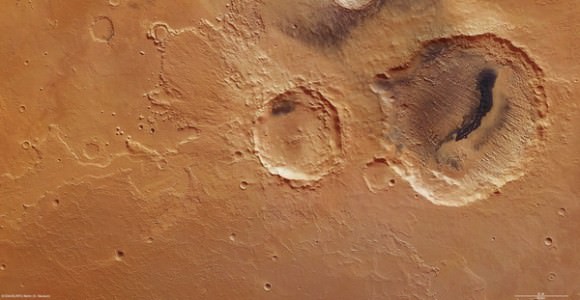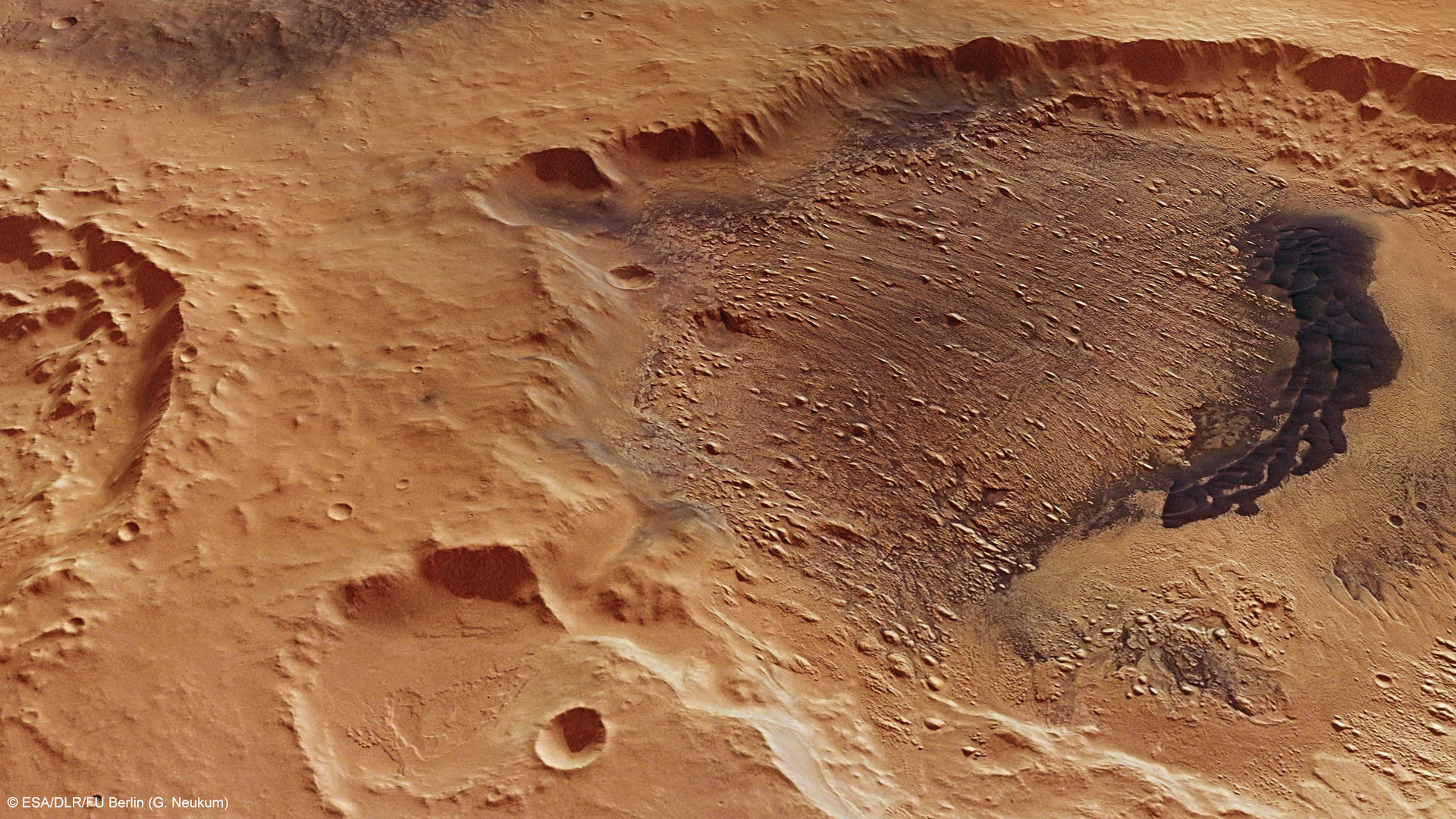[/caption]
The term ‘yardangs’ almost sounds like a fictional word from a Barsoomian tale of creatures living on Mars. However, this is a real word, a geologists’ term for narrow, wind-eroded ridges. These are common land features in the desert regions of Earth, eolian features created by wind and dust. With Mars’ dusty soil and frequent winds, these landforms are common on the Red Planet, too. The abrasive dust is blown by wind, impacting on the bedrock, slowly removing parts of the surface, like a sand-blaster. If the winds blow in the same direction for a long enough period, ‘wind-lanes’ are made. These features are called yardangs.
These latest images from the Mars Express mission show yardangs on the floor of Danielson crater, and scientists think this crater may provide evidence that the planet underwent significant periodic fluctuations in its climate due to changes in its rotation axis.
On June 19, 2011, Mars Express took a look at the region pictured here — Arabia Terra region of Mars — imaging Danielson and the smaller Kalocsa crater with its high-resolution stereo camera.
In the case of Danielson crater, scientists think the sediments were cemented in by water, possibly from an ancient deep groundwater reservoir, before being eroded by the wind.

The orientation of the yardangs leads scientists to theorize that strong north–northeasterly winds (from the lower right in the image) both deposited the original sediments and then caused their subsequent erosion in a later drier period of Martian history.
A 30 km-long field of darker dunes can be seen bisecting the yardangs and is thought to have formed at a later epoch.
Some scientists believe that this indicates periodic fluctuations in the climate of Mars, triggered by regular changes in the planet’s axis of rotation. The different layers would have been laid down during different epochs.
But Kalocsa crater shows a completely different topography, with no layered sediments. This is thought to be due to the higher altitude of its floor, with the crater not tapping in to the suspected underlying ancient water reservoir.
However, another hypothesis is that this crater is younger than its neighbor, created when water was not present anymore.
Dang.
Source: ESA


my roomate’s mom got paid $ 14828 past week. she is making an incom e on the internet and bought a $481700 house. All she did was get fortunate and put into use the guide exposed on this web site
?????? (Click At My Name For Link)
my buddy’s step-mother makes $62 hourly on the internet. She has been out of a job for 6 months but last month her check was $20978 just working on the internet for a few hours. Read more here
?????? (Click At My Name For Link)
Here is a recent theory that predicts such snowmelt sediments as here and the massive sulfur top sediments on the top of the Gale crater mound.
“They find that melting occurs for certain configurations of orbital parameters …
If these conditions are satisfied, liquid water can melt on the surface. This “snowmelt” can deposit material, over time forming sedimentary rocks. Order of magnitude calculations show that this process could create a significant enough layer to explain the rover observations. …
Based on their models, the authors provide half a dozen testable predictions for the Mars Science Laboratory at the Gale Crater, where this snowmelt process is predicted to be important.”
On a similar note I became aware of “HYDROUS MELTING OF THE MARTIAN MANTLE PRODUCED BOTH DEPLETED AND ENRICHED SHERGOTTITES”, McCubbin et al, which should be published in Geology soon. (And anyway was presented during the 43rd Lunar and Planetary Science Conference (2012).)
They have studied martian meteorites and have, if I understand them correctly, for the first time estimated Mars (mantle) water content. It is the same as Earth or not too much wetter!
“Importantly, this range of values overlaps with estimates of the water content in the terrestrial mantle”.
Yay! So actually terrestrial dryness of 0.005 per mass water instead of the average asteroid 0,1 per mass, the rather finetuned balance between having enough for life but not too much for land, may be fairly universal. Likely thanks to the aggregation process that gets rid of the surplus.